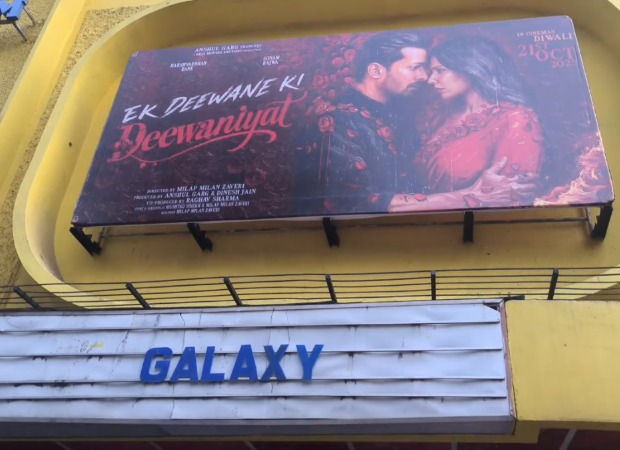The Diwali release, Ek Deewane Ki Deewaniyat, has emerged as a huge hit at the box office. The credit, of course, goes to the film’s director, Milap Zaveri, lead actors Harshvardhan Rane and Sonam Bajwa, the hit music, and producer Anshul Garg’s determination. Two more people deserve the credit – Aman Gill and Gaurav Verma. Aman has had a run-in marketing, distribution, talent management, production, etc., having worked in prominent production houses like Viacom18 Motion Pictures, Junglee Pictures, Balaji Motion Pictures before turning producer. As for Gaurav, he has worked in programming at PVR Cinemas, headed distribution at PVR Pictures, followed by an illustrious journey in distribution at UTV Motion Pictures. He played several roles including Chief Revenue Officer, Chief Operating Officer, and Producer at Shah Rukh Khan’s Red Chillies Entertainment.


EXCLUSIVE: 2200 screens. Zero trade expectation. Massive payoff — The brains behind Bollywood’s biggest Diwali surprise, Aman Gill and Gaurav Verma, decode their GENIUS release strategy for Ek Deewane Ki Deewaniyat!
Both not only gave a strategic release to the film but also played a huge role in correctly marketing it. They had several challenges in front of them – Ek Deewane Ki Deewaniyat was massively underestimated by trade and industry and moreover, they faced competition in the form of Thamma. But the duo took these challenges head-on and used their 20+ years of experience in the film industry in various capacities to position the film correctly. Today, their efforts have borne fruit and how.
They are least surprised by the film’s box office outcome. Aman said, “We knew what the film would collect. I was a part of the first Rs. 100 crores Hindi film, that is, Ghajini (2008). Gaurav was a part of the first Hindi film to collect Rs. 600 crores in India and Rs. 1200 crores worldwide, that is, Jawan (2023). I don’t think there would have been more experience in the last 20 years!” In an exclusive interview with Bollywood Hungama, Aman Gill and Gaurav Verma opened up extensively about their idea behind Ek Deewane Ki Deewaniyat’s release. They were also joined by Deepak Upreti, a veteran who has overseen the release of over 600 films and helmed distribution at UTV, Disney, and Fox, and who also distributed the Diwali love saga.
Fact check: Did Ek Deewane Ki Deewaniyat not get adequate screens?
A complaint that arose with regard to Ek Deewane Ki Deewaniyat was that it didn’t get enough cinemas, especially single-screen theatres. Gaurav Verma burst this myth at the very onset, “You can go for a wide release, but if only 15 people are watching a film, the experience of watching a film automatically drops.”
Aman Gill added, “It’s common to see many distributors simply acting like bookers. They demand all shows from 8:00 in the morning. But they don’t know what their product is and whether it demands such a kind of showcasing.”
He continued, “This was a missing piece and we realized that while working on this film. Nobody had this film on their radar. In June-July, the expectation was that it would open at Rs. 1 or 2 crores, or max at Rs. 2.50 crores. Nobody had hopes from Harshvardhan Rane. Sanam Teri Kasam’s (2016) re-release success was considered a fluke!”
Explaining how the film was scheduled for a festival release, Aman said, “As soon as we took up the film, we announced a Diwali release. Many were shocked as it meant clashing with Thamma. The producer thought of releasing the film on October 2. But Sunny Sanskari Ki Tulsi Kumari took that slot. Meanwhile, the Kartik Aaryan-Sreeleela film was shifting from Diwali and hence, we decided to come on the Festival along with Thamma. We were clear – we were not chasing Rs. 20 crores. We were chasing Rs. 10 crores day 1.”
Both Aman Gill and Gaurav Verma explained how there was more than enough space for both films to score at the ticket window. Gaurav Verma gave some pertinent instances, “The Diwali 2024 releases – Singham Again and Bhool Bhulaiyaa 3 – collected more than Rs. 70 crores on the first day. This means that the capacity was of Rs. 100 crores or Rs. 105 crores. Also, 3 films were released on Independence Day last year. They collected around Rs. 61.50 crores on the first day – Stree 2 earned nearly Rs. 50 crores, Vedaa collected Rs. 6 crores while Khel Khel Mein’s collections were Rs. 5.50 crores. It is obvious that the entire capacity was not going to be utilized. Hence, there’s always a shot for the second film.”
He further stated, “Now, Stree 2 is the flag-bearer of the universe (that Thamma also belongs to). It opened at Rs. 50 crores and so, that was the cap for Thamma. To hit Rs. 50 crores, you need a Rs. 70-75 crore capacity. You’re still leaving Rs. 30-35 crore capacity on the ground. For a film like Ek Deewane Ki Deewaniyat, at best, you need a Rs. 24-25 crores capacity to hit Rs. 10 crores. So, people didn’t see it mathematically.”


Gaurav also explained, “We need to understand the concept of capacity. Screen se paise nahin aate hai. Shows se paise nahin aate hai. Utilization of shows se paise aate hai. Until people don’t understand this math, we’ll still be fighting for screens. Sometimes, we fight battles for egos. That’s not pro-business.”
Aman Gill also remarked that viewers would travel a bit far to watch the film, if they are genuinely interested, “Today, a theatre like Chandan Cinema in Juhu, Mumbai has disappeared. Do you think a person who used to frequent Chandan has stopped watching movies? That crowd would now visit Sun City or Cinepolis Andheri or go to PVR Juhu when tickets are cheaper. Some will go as far as Gaiety-Galaxy in Bandra. But they’ll find a cinema. The audience is not going to disappear.”
He also said, “Many groused that we didn’t get enough single screens. But just because someone blocks a single screen, it doesn’t mean that you block the audience. Back in the day, we used to release the film in 200-250 cinemas. Ghajini (2008) was our biggest release, in 500 cinemas. Welcome (2007) had a release in 360 theatres. Then, the situation was different; if I didn’t get a particular cinema, I would have no way to serve the audience in that area and I would thereby lose business. Today, if Chandan in Mumbai or Liberty in Karol Bagh, Delhi is not playing the film, the audience in a 10 kms radius has 5 other outlets to consume the same film. And this is across the country. In Lucknow, there are 4 single screens. It was signed by Thamma’s team in advance. But there are 15 multiplexes in that city. The audience managed to see the film in one of these theatres.”
Deepak Upreti noted, “In the first few days, we did lose out on a few of the single screens. Yet, the collections didn’t drop. The single-screen theatres lost business. Had they done show-sharing, it would have proved beneficial to them.”
He continued, “Hence, distribution is not what it used to be. The game has changed. You need to understand your product more than ever. Distributing is the end of understanding what your product is from the start! You should know the project from the start, how you’ll market it, who the audience is that you are chasing, where are they living and how you are placing it to them. With Ek Deewane Ki Deewaniyat, we were not chasing Mumbai city. We knew that the audience for it was outside Mumbai. This understanding needs to be there before you start the marketing campaign of your film.”
Identifying the niche
Gaurav Verma explained, “Very few films cater to the entire universe. These are the ones that open at Rs. 50 crores. In fact, only 7 films have opened at more than Rs. 50 crores – Pushpa 2, Jawan, Animal, Pathaan, War, Stree 2 and Thugs Of Hindostan. The rest of the films are catering to a niche. How big will that niche be needs to be considered along with the fact that how it will be consumed and in which pocket. This is what distribution is primarily. Distribution is not taking the film to the cinema. Distribution is understanding your film, understanding your consumer and placing it very close to that consumer so that it’s available to him/her.”
He opened up on how they procured screens despite competition from Thamma, “The other film had the dominant hand. Their film was bigger and they had the pressure of delivering the numbers. Hence, we knew that we would have the stress of getting screens. You know that when you are in a clash, the noise of the other film can outshout your film, especially when yours is a smaller film. Today, he (Dinesh Vijan) is the biggest producer and the film belongs to one of the biggest universes. So, a lot of things went in their favour. What worked in our favour was that we were targeting a niche. In fact, people didn’t realize it. None of us were expecting that we were going to get ample screens. Yet, we went to some 1700 locations and 2200 screens. This is as big as a normal film. Instead, everyone chose to harp on the fact that we didn’t get single screens! But we were aptly placed. Today, in Bihar, we are collecting more than the competing film. Sure, we got fewer shows in Patna. But that audience will go to some other cinema hall. This is why I am operating at higher occupancy. My weekday figures are also encouraging. The same goes for Gujarat, Rajasthan, Central belt, Punjab, Eastern UP, Lucknow, Agra etc.”


Aman Gill added, “Even Delhi city.” Gaurav agreed, “Yes. Delhi’s Delite Cinema’s small hall, Diamond Theatre, ran full for 7 days!”
Aman said, “The film opened more than the expectations. The general industry expectation was that it would open at Rs. 4 crores. I was told, ‘Rs 5 crores pe khuli toh bahut badi baat hai’!”
Deepak Upreti revealed, “Most distributors don’t get to see the film in advance or they are not aware of the final product. Either they are watching the film very close to the release, much after the campaign has started, or they don’t get to see the film at all. In other words, they are playing blind and servicing the campaign and not the film, which may or may not be true to the product. This didn’t happen with this film.”
Gaurav further said, “We had exposure to the content and we knew the campaign that we were going to build. We knew the audience that we were going to target. Hence, we had confidence. What is very disheartening is that closer to the release, the buzz was not being read by anybody. It proved how disconnected we are. A lot of exhibitors not betting on this film was the biggest surprise despite over-utilization of capacity by a particular film. It was 2-3 days before release that everyone realized that the film, which they felt would open at Rs. 3 crores, can now cross the Rs. 10 crore mark. Still, while everyone spoke about the double digit, no one was betting on it!”
Understanding the region and the cinema hall behaviour
Gaurav Verma continued with his masterclass on distribution as he said, “Many don’t understand cinema behaviour. Every region has a consumption pattern. For instance, Kantara: A Legend Chapter – 1 is doing so well in Maharashtra. But is it doing the same in UP? So, we need to understand the behaviour of the region and also that of the various cinema halls in that region. For instance, in Chitra, Star City, Paradise and Aurora were located within a 2 km radius in central Mumbai. Does every cinema exhibit the same behaviour? It’s very important to understand this part. You also need to understand your film and place it accordingly.
Deepak Upreti explained, “PVR Juhu and PVR Lower Parel will not see the highest occupancy for our film. But when you consider Mukta A2 Jai Hind Lalbaug or the cinemas in Borivali or Ghatkopar, the occupancy starts changing.”
Aman Gill added to this point, “Ek Deewane Ki Deewaniyat was played in Gaiety-Galaxy. That’s where my audience is and I’ll fight for such cinemas. Similarly, we fought aggressively in Hindi heartland, Central belt, Rajasthan, Gujarat, Punjab, Bihar and UP. In the places where our audience was limited, we were okay to not be so aggressive. What people haven’t realized is the way Bihar is performing for this film is akin to a film opening at Rs. 20 crores.”
Gaurav continued, “Even in Bihar, Odisha, Eastern UP, Rajasthan, CI and Gujarat, it’s not like we got shows in some cinemas on the first day of release, October 21. We got some theatres on Wednesday, Thursday and even Friday. We had to keep evaluating and growing where the film had potential. You can’t dump your film and shut down your phone. It’s compulsory to constantly monitor your film.”
Fantastic overseas response
Not just in India, but even abroad, Ek Deewane Ki Deewaniyat has managed to surprise. Gaurav Verma said, “Nobody had any hopes from this film Overseas as well. We were able to earn a million dollars by the end of the first weekend. Our friends at Phars Films backed our conviction, along with all our various partners in Overseas who helped us in in giving it a very wide release.”
He stated, “It has done well in all territories and is exceptional in the United Kingdom. To collect $1.4 million in 10 days is a huge achievement. The acceptance of the film is phenomenal outside of India. We released it in 700-odd locations. It’s a crazy number and as big as it gets. It’s much bigger than the mid-level films. But we did it as we had belief in it. The only thing to be done was to place it correctly, in India and Overseas. In the UK, USA, Fiji, Mauritius, the Middle East etc, we led the campaign. The film didn’t just drop all of a sudden.”
More Pages: Ek Deewane Ki Deewaniyat Box Office Collection , Ek Deewane Ki Deewaniyat Movie Review
BOLLYWOOD NEWS – LIVE UPDATES
Catch us for latest Bollywood News, New Bollywood Movies update, Box office collection, New Movies Release , Bollywood News Hindi, Entertainment News, Bollywood Live News Today & Upcoming Movies 2025 and stay updated with latest hindi movies only on Bollywood Hungama.




